LLÁMENOS/WHATSAPP: +91 6304795901 O ENVÍENOS UN CORREO ELECTRÓNICO A contact@wanderwise.me
THIRUVANAMALAI TEMPLE TRAVEL GUIDE
THIRUVANAMALAI TEMPLE TRAVEL GUIDE: Seeking a spiritual journey ? This Temple offers an experience steeped in ancient traditions and a profound serenity.
5/21/202520 min leer
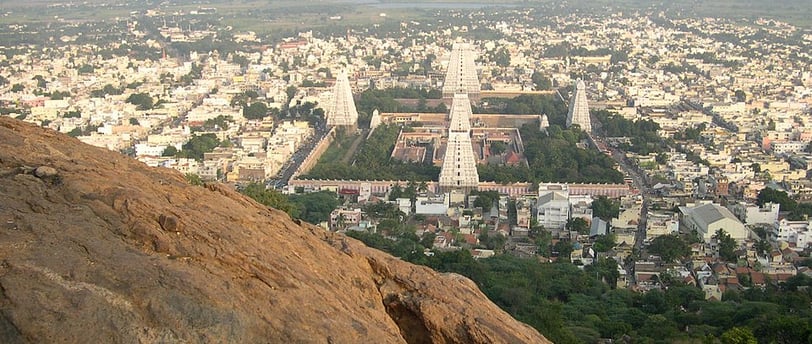

TEMPLE AT THIRUVANAMALAI
INTRODUCTION
A two-and-a-half-hour drive from Kanchipuram lies Thiruvanamalai, one of the sacred places in South India. Known for its mystical temple and the revered sage Ramana Maharishi, Thiruvanamalai is a magnet for seekers and spiritual wanderers alike. A minimum stay of two nights in the town of Thiruvanamalai is recommended. After a day well spent exploring Kanchipuram, you’ll arrive in the evening, ready to indulge in a delicious dinner and enjoy a restful night. Your spiritual journey will begin the following morning, refreshed and ready for the adventures that lie ahead.
Thiruvanamalai is special on so many levels — spiritual, cultural, and even geological! Here’s a breakdown of what makes it stand out:
The Sacred Mountain – Arunachala
The town is built around Arunachala Hill, which is not just a hill but considered a manifestation of Lord Shiva himself in the form of fire. Many believe that just seeing the hill (called Darshan) is spiritually purifying.
Arunachaleswarar Temple
One of the largest temples in India dedicated to Lord Shiva as Annamalaiyar. Famous for its massive gopurams (temple towers), sprawling courtyards, and deep spiritual energy. The temple is a key site for the Karthigai Deepam festival, where a giant flame is lit on top of Arunachala hill — visible for miles!
Spiritual Heritage – Ramana Maharishi
The town is where Ramana Maharishi, one of India’s most beloved modern-day sages, lived and taught. His ashram is still active, drawing people from around the world seeking inner peace through self-inquiry ("Who am I?").
Girivalam – The Sacred Circumambulation
Every full moon, thousands walk the 14-km path around the hill, called Girivalam, in silence or prayer. It's a blend of pilgrimage, meditation, and cardio — all under the moonlight.
The town
Talking about Thiruvanamalai only as a temple town is like describing a galaxy by pointing out just one star. The temple may be the crown jewel, but the sages, siddhars, and mystics are the ancient pulse that gives the place its soul. It would be like admiring the flame and forgetting the fire.
Thiruvanamalai is believed to be a stronghold of Siddhars — mystical yogis with supernatural powers who achieved siddhi (perfection or enlightenment). Some say they're still around, just... not always visible.
Boghar, Agastya, and other ancient siddhars are said to have meditated here or passed through. Local legends whisper about caves around Arunachala Hill where siddhars still reside, either in deep meditation or chilling in a dimension slightly outside of ours.
Thiruvanamalai means ‘the unreachable mountain’ — a name that whispers a deeper truth: you don’t come here by chance; you come because the mountain has called you.
Oh yes — Thiruvanamalai isn't just the Ramana Maharishi show (though he’s the headliner & the chief amongst the mystics here); it’s been a magnet for sages, mystics, and siddhars for centuries. This hill doesn’t just attract visitors — it summons them.
A few other famous & well known sages of the place.....
Sri Seshadri Swamigal
A contemporary of Ramana Maharishi, he was known for his wild, unpredictable behaviour that masked a deep, compassionate wisdom. Called the "Saint with the golden hand" because anything he touched would thrive — businesses, sick people, and temples.
Yogi Ramsuratkumar – The “Beggar Saint”
A modern mystic often seen wandering with a fan and muttering "Ram Ram Ram." Though he appeared as a beggar, he was revered for his divine presence. His ashram is a peaceful, powerful place tucked right into the town — well worth a visit.
Pambatti Siddhar
Literally means “Snake Charmer Saint.” He’s one of the 18 Tamil Siddhars and is believed to have spent time in Thiruvanamalai. He often spoke in riddles and snake metaphors about kundalini and divine consciousness.
For those on a spiritual quest, not visiting this temple town is akin to setting off on a treasure hunt without a map — the journey may be meaningful, but you maybe be missing the key to unlocking the deepest secrets.
Let’s immerse ourselves and plunge into the profound spirituality that defines this town. Shall we?
GETTING THERE: LOCATION, TRAVEL TIPS & TIMINGS
At the heart of the town, with the mighty Arunachala mountain standing watch in the background, the majestic Arunachaleswarar temple calls to all — its towering white gopurams broadcasting an invitation, echoing a divine summons to those who seek its sacred presence.
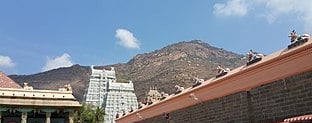

The Arunachaleswarar Temple in Thiruvanamalai is surrounded by a constellation of ashrams, each offering a sacred space for spiritual seekers, with the Ramana Maharishi Ashram standing as a prominent and revered centre. This area, a blend of both humble and grand lodges, is a sanctuary for those on a spiritual journey, drawn from all corners of the world. Pilgrims and seekers move seamlessly between the temple and the ashrams, quietly waiting the elusive moment of transcendence and to realize a glimpse of what lies beyond the physical realm.
Here, amid the serene environment and the echoes of wisdom passed down through generations, one finds not just a place of worship, but a profound invitation to connect with the eternal. The teachings of Ramana Maharishi and the surrounding natural beauty create an atmosphere of quiet reflection, where time seems to stand still and the search for deeper truth unfolds in its own gentle rhythm.
Temple Timings: 6.00 am to 12.30 pm & 4.00 pm to 8.00 pm & 6.00 am to 10.00 pm (On functions and ceremony days)
Ashram Timings:
The Sri Ramanasramam Ashram is open from 5:30 AM to 8:30 PM daily. The main hall may be closed for rest and cleaning from 12 Noon to 3.00 pm
Skandasramam, located on the hill, is open from 8 AM to 5 PM.
The Sri Seshadri Ashram in Thiruvannamalai is open for worship from 6:30 am to 11:30 am in the morning and 4:30 pm to 8:30 pm in the evening.
PARKING: WHERE TO LEAVE YOUR VEHICLE
If you are self driving; the parking spaces next to the West gopuram are typically occupied by cabs, while those near the North and South gopurams are reserved for private cars. Larger buses typically drop passengers off at a convenient spot, from where it's about a 500-meter walk to the temple. On the return journey, the bus will pick you up at the same spot - when you're ready call the driver.
FOOTWEAR ETIQUETTE & DRESS CODE: TO KNOW BEFORE YOU GO
Now, business as usual—and by that we mean: no footwear allowed inside the temple. Sacred ground but Socks okay. There's no grand, organized shoe stand with numbered tokens and polite staff or DIY shoe-drop system at one of the near-by kiosks, to keep watch over your footwear - for a tip at the end of your visit.
THE TEMPLE: HISTORY, ARCHITECTURE & CULTURAL SIGNIFICANCE
The Arunachaleswarar temple spans an area of 10 hectares, making it one of the largest temples in India. While its origins can be traced back to the 11th century, the majority of the existing structures were constructed between the 17th and 18th centuries. The existing masonry structure was originally constructed during the Chola dynasty in the 9th century CE. Subsequent expansions were carried out under the Vijayanagara Empire, from (1336–1570 CE).
This is one of the rare temples with gopurams facing all four cardinal directions, drawing seekers from every corner of the world — and as if to mirror its spiritual purity, these towering gateways are cloaked in serene white.
Here, Shiva is worshipped in his elemental form as Agni — the sacred fire — radiating transformation, illumination, and inner awakening. Shiva blazes forth as fire — not just as a symbol, but as a living presence that burns away illusion and lights the path to liberation.
The legend
In ancient times, Goddess Parvathi, the consort of Lord Shiva, once playfully closed the eyes of her husband while they were in a flower garden atop Mount Kailash. Although this act lasted but a moment in celestial time, it had catastrophic consequences for the universe. As Shiva is the source of light and energy, his momentary blindness caused the entire world to be engulfed in darkness. This darkness persisted for several years on Earth, despite the briefness of the event in divine time.
Realizing the gravity of the situation and the suffering it caused, Parvathi sought a way to restore balance. With great remorse, she undertook rigorous penance in the forests of the earth, her devotion culminating at the sacred hill of Arunachala. In response to her fervent prayers, Shiva manifested himself as a brilliant column of fire at the summit of Arunachala, thus bringing light back to the world and dispelling the darkness.
This manifestation of Shiva, known as Arunachaleswarar, symbolizes the return of cosmic balance. The hill itself is revered as a divine form of Shiva, and the event is seen as the union of the divine masculine and feminine energies of Shiva and Parvathi.


Exploring the temple – The gopurams
The temple features four prominent gopurams (gateway towers), with the principal entrance, the Raja Gopuram, oriented towards the south.
In Arunachaleswarar Temple, the gopurams aren’t just doorways; they’re like portals to parallel festival universes. Each one plays a distinct role in the temple’s bustling calendar of events, and knowing which gopuram is the stage for what occasion is like having VIP access to the spiritual show.
The Arunachaleswarar Temple is accessible through all four of its major gopurams, which are located at the cardinal directions: Raja Gopuram 66 meters tall (217 feet) (South) – This is the main and tallest entrance, and the most frequently used by devotees and visitors.
Other gopurams are:
Thirumanjana Gopuram (West), named after the sacred “Thirumanjanam” or ceremonial bathing rituals performed for the deity. The west-facing entrance aligns with specific festival processions and rituals held during particular times of the year.
Ammani Amman Gopuram (North) named after the goddess this entrance is sometimes used during special festivals involving female deities or associated shrines.
The Pey Gopuram (East). “Pey” in Tamil can refer to spirits or supernatural beings, but in this context, it may denote ancient or mystic traditions associated with this entrance. It is considered the oldest of the four, with less ornamentation but a more austere, powerful presence. The east-facing orientation aligns with the rising sun, traditionally considered auspicious in Hindu temple architecture.
Each gopuram serves as an entry point into the vast temple complex, and they are richly adorned with intricate sculptures characteristic of Dravidian temple architecture.
No matter through which gopuram you enter it’s as if the gopuram leans in to whisper: ‘Welcome, mortal… you’ve been granted a rare chance to glimpse the highest wisdom. Don’t let it slip away.’
The Dwaja Sthambam (Flag pole)
It signals that the divine energy of the deity is present in the temple.
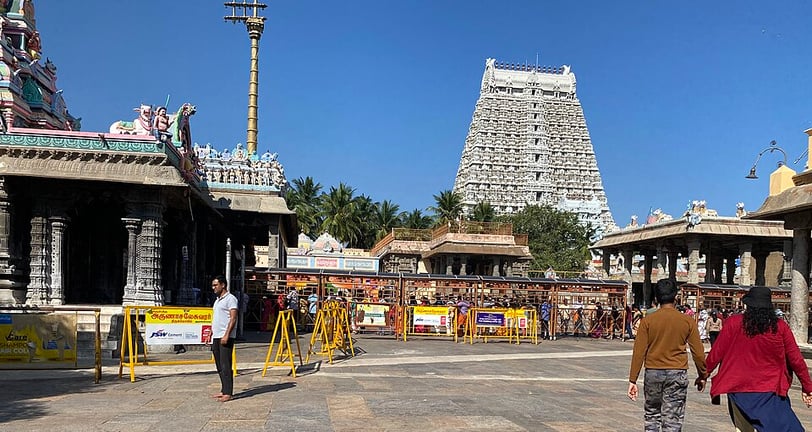

The temple tanks
While most temples are typically associated with a single sacred temple tank, the Arunachaleswarar Temple is notably unique in having several such tanks. Among these, the Brahma Theertham (Theertham a Sanskrit term that literally means "sacred water"), Agni Theertham, and Indira Theertham are particularly noteworthy. Each tank is distinguished by its own legend, specific purpose, and unique function within the temple tradition.
Important shrines of the temple
The Arunachaleswarar Temple, a towering beacon of Shaivite devotion, houses a constellation of sacred shrines that together create a tapestry of myth, legend, and deep spiritual energy. At its heart lies the sanctum of Lord Arunachaleswarar, representing Shiva in his fiery Agni form, one of the five elemental manifestations. Beside him resides Unnamulai Amman, the serene yet powerful form of Parvathi, radiating divine grace. Tucked away in a tranquil corner is the shrine of Kambattu Ilayanar, Lord Murugan, beloved son and warrior-god. The ever-watchful Chandikeswarar stands guard near the sanctum, receiving devotees with the traditional clap of reverence. The Navagraha shrine accommodates celestial concerns, while the subterranean Patala Lingam draws spiritual seekers to the very spot where Ramana Maharshi is said to have realized the Self. The temple also honors the fierce goddess Durga, and pays tribute to the revered Shaivite saints—Sambandar, Appar, Sundarar, and Manikkavachakar—whose hymns still echo in the hearts of pilgrims. Together, these shrines form not just a temple, but a living cosmos of devotion and divine presence.
As a foreign visitor, you may neither have the time nor the inclination to explore every shrine within this vast temple complex. However, for devout Hindu pilgrims—often visiting with no constraints of time—these shrines hold deep spiritual significance and are an integral part of their journey. That said, if you are inclined and curious, there is no reason not to explore a few of these sacred spaces yourself; each one offers a unique glimpse into the rich tapestry of devotion, mythology, and architectural grandeur that defines the Arunachaleswarar Temple. Why not?
The circumambulation
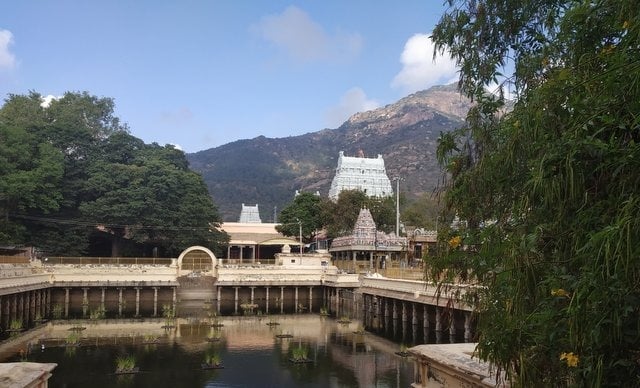

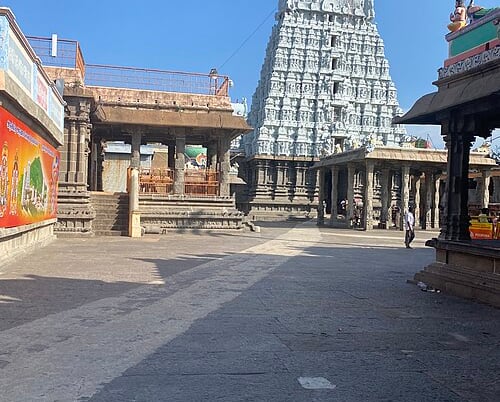

In Hindu traditions, it is customary to come around the main shrine in circumambulation which is part of a ritual to cleanse the mind and seek favours from the gods.
Circumambulation, or pradakshina, in the outer prakaram (enclosure) of the Arunachaleswarar Temple is a deeply symbolic and spiritually enriching act. Unlike the grand 14-kilometer Girivalam path that encircles the sacred Arunachala hill, the temple’s outer prakaram offers a more intimate journey—one that allows devotees to walk slowly around the towering sanctum, soaking in centuries of devotion, intricate stone carvings, and the rhythmic pulse of temple life. Each step taken in reverence is believed to dissolve karma, center the mind, and draw the devotee closer to the divine presence of Lord Arunachaleswarar. The path is lined with shrines, mandapams, and sculptural marvels, making the circumambulation not just a ritual but a quiet pilgrimage in itself—accessible, contemplative, and profoundly moving.
The scared tree of the temple
Interestingly, the Arunachaleswarar Temple is associated with not just one, but two sacred trees—the Banyan tree (Aala Maram) and the Magizham tree (Mimusops elengi) depending on which circumambulatory passage you are in (Outer or inner respectively).
The sacred tree (Sthala Vriksha) of the Arunachaleswarar Temple is the Magizham tree (Mimusops elengi) common name Indian Medlar or Spanish Cherry, known for its small, fragrant white flowers and evergreen leaves. In Tamil tradition, each temple is associated with a specific tree believed to embody the spiritual essence of the place, and the Magizham holds that honour here. This tree is not only botanically significant but also deeply symbolic—it represents serenity, devotion, and timeless beauty. Devotees often circumambulate the tree; tie sacred threads to its branches, or offer prayers beneath its shade, believing it to be a silent witness to centuries of worship and a living conduit of divine blessings.
Note: By now, through my earlier blog posts, you will have become familiar with recurring elements commonly found in Hindu temples—such as gopurams (gateway towers), mandapams (pillared halls), temple tanks, and sacred trees. Yet, it is important to recognize that while these features may appear similar across temples, each is uniquely shaped by its own mythology, legend, function, and subtle architectural variations. One key understanding—especially from an architectural perspective—is that Hindu temples were never designed to entertain. The deliberate repetition and familiar structure serve a deeper purpose: to create a sense of continuity and stability that grounds the mind and soul. In a world that is constantly shifting and overwhelming, the temples’ architecture offers a space of order, rhythm, and sacred stillness—a sanctuary for inner alignment and spiritual focus.
FESTIVALS & CELEBRATIONS: THE TEMPLE IN FULL SPLENDOR
While all the major festivals of other Shiva temples are also celebrated here, (which you can get to know from other previous blogs) few festivals that are very special to this temple deserves mention: The Karthigai Deepam, Chittirai Vasanta Utsavam, Vaikasi Utsavam, Ani Brahmotsavam, Adi Pooram Brahmotsavam, Avani Moolam Utsavam, Navarathri Utsavam, and Annabisheka Utsavam.
Karthigai Deepam, the most revered festival at the Arunachaleswarar Temple in Tiruvannamalai, takes place during the Tamil month of Karthigai (November–December). The festival reaches its spiritual climax with the lighting of the Maha Deepam (the great lamp) atop the 2,668-foot Arunachala Hill, symbolizing Lord Shiva’s boundless presence as a pillar of fire. A colossal cauldron, filled with nearly 3,500 litres of pure ghee, is set ablaze, casting a radiant glow visible across the region. This awe-inspiring moment draws millions of devotees, who gather to witness the sacred light and chant “Annamalai Harohara - is something like the Hallelujah” in deep devotion.
The ten-day Karthigai Deepam festival begins with the ceremonial Dwajarohanam, or flag hoisting, marking the formal commencement of the celebrations. Each day features grand processions of the Pancha Murthigal—the five principal deities—who are paraded through the streets surrounding the Arunachaleswarar temple in richly decorated chariots. A key spiritual practice during this time is Girivalam, a sacred 14-kilometer circumambulation around the Arunachala Hill. Devotees walk barefoot along this path, believing the journey absolves past sins and brings divine grace and inner transformation.
Chittirai Vasanta Utsavam held in the Tamil month of Chittirai (April–May), this spring festival celebrates the divine marriage of Lord Shiva and Goddess Parvati. The temple is adorned with flowers, and the deities are taken out in processions, symbolizing the union of the divine couple and the onset of the spring season.
Vaikasi Utsavam is celebrated in the month of Vaikasi (May–June). This festival marks the celestial wedding of Lord Sundareswarar (a form of Shiva) and Goddess Meenakshi. At Arunachaleswarar Temple, it involves special rituals and processions, emphasizing the themes of divine love and prosperity.
Ani Brahmotsavam, observed in Ani (June–July), Brahmotsavam is a grand festival featuring elaborate processions of deities on various vahanas (vehicles). It signifies the cosmic functions of creation, preservation, and destruction, with rituals aimed at invoking divine blessings for the community.
Adi Pooram Brahmotsavam, observed in the Tamil month of Adi (July–August), this vibrant festival is dedicated to Goddess Andal, revered as an incarnation of Bhudevi and a passionate devotee of Lord Vishnu. At the Arunachaleswarar Temple, the occasion is marked by elaborate pujas and ceremonial processions, offering a heartfelt tribute to divine femininity, unwavering devotion, and the spiritual power of the goddess.
Avani Moolam Utsavam takes place in Avani (August–September). This festival commemorates Lord Shiva's cosmic dance (Ananda Tandava). The temple hosts enactments of this divine dance, highlighting themes of creation and destruction in the universe.
Navarathri Utsavam: During Navaratri (September–October), the temple celebrates the nine nights dedicated to Goddess Durga. Each day honours a different form of the goddess, with rituals, music, and dance performances, culminating in Vijayadashami, symbolizing the victory of good over evil.
Annabisheka Utsavam is held in the Tamil month of Aippasi (October–November). Annabisheka involves the anointing of the Shiva Lingam with cooked rice, symbolizing gratitude for the harvest and sustenance provided by the divine. It's a unique ritual signifying the nourishment of both body and soul.
PHOTOS: WHAT’S ALLOWED, NOT, ANGLES, LIGHT & GOLDEN HOUR
Photo angles & perspective
Thiruvanamalai offers abundant opportunities for photographers, whether you're capturing the majestic temple, the spiritual energy, the ashrams or the natural landscapes.
Architectural Details: The Arunachaleswarar temple has intricate Dravidian architecture, so focus on the fine details—gopurams (towers), pillars, and sculptures. Capture close-up shots of these elements to highlight their craftsmanship.
Wide-Angle Shots: To capture the entire temple complex or the hill, use a wide-angle lens. This allows you to get sweeping shots that include both the temple's grandeur and the surrounding landscapes.
The Sacred Hill: Arunachala Hill is a central feature of the town and a revered site. Capture it from various angles, including from the Girivalam path or from one of the ashrams with a wide lens to include the hill, the surrounding vegetation, and any pilgrims in the foreground.
Reflection Shots: If you visit the temple tanks, such as the Brahma Theertham or Agni Theertham, try to capture the reflections of the temple in the water. Early morning is the best time for such shots when the water is still and calm.
Candid Shots of Pilgrims: The local population and pilgrims bring life to the streets around the temple. Capture candid moments of devotion, prayer, or rituals. Look for natural expressions and interactions to evoke the spiritual vibe of the place.
Market and Street Scenes: Around the temple, you'll find street vendors selling coconuts, flowers, and religious items. These bustling scenes add a sense of life to your photos. Don’t be afraid to capture the busy market, but always ask for permission before taking portraits of individuals.
Festivals and Rituals: If you happen to visit during a local festival or a special religious event, the vibrancy of the rituals provides excellent photographic opportunities. Be respectful and mindful of the customs and avoid taking intrusive photos.
Photographers’ recommendations
A wide-angle lens (16-35mm or 18-55mm) is ideal for capturing large structures like the temple and the hill. For portraits or details, consider a prime lens with a larger aperture (50mm f/1.8 or 85mm f/1.4) to achieve beautiful depth of field and focus. Of course a tripod for stabilization
Drone Photography: If you have access to a drone and the necessary permissions, aerial shots can provide a unique perspective of the temple complex. Ensure compliance with local regulations regarding drone usage.
EXPLORING THE SURROUNDINGS: AROUND THE TEMPLE COMPLEX
Exploring the ashrams
In addition to the familiar sights around the temple—such as silk shops, cafés, and coconut vendors—one of the essential experiences is visiting the ashrams located in and around the temple area. The word "ashram" is derived from the Sanskrit root śram, meaning "to exert effort" or "to strive." The prefix "a" conveys a sense of negation, suggesting a departure from the mundane struggles of daily life and an entry into a sacred space dedicated to spiritual practice and inner exploration.
The closest English equivalent to the term ashram might be "hermitage," but there is a significant distinction. In India, ashrams are invariably associated with a realized divine mystic—a spiritual teacher or guru who embodies profound wisdom and enlightenment. An ashram is not merely a place for spiritual practice shared by like-minded individuals; it is, in fact, illuminated by the eternal presence of a realized being. When the right seeker encounters this presence, the transformative power of the guru’s wisdom can be imparted, often through their mere proximity.
Among the various ashrams in the area, the Ramana Maharshi Ashram holds the foremost position in this town. Revered for its deep spiritual significance and the transformative presence of the great sage, it stands as the leading centre of spiritual practice and enlightenment, drawing seekers from around the world.
I will not delve into the deeper aspects of Ramana Maharishi’s transformative journey, his meditation method through the "Who am I?" inquiry, or other profound teachings, as these are topics worthy of an entirely separate blog. My focus here is to highlight the key aspects of some must-see places in the area, offering a practical guide to the spiritual landmarks that define this town.
Ramana Maharishi’s meditation cave:
While the main Ramana Maharshi Ashram is located at the foothills of Arunachala, a visit to Thiruvanamalai would be incomplete without a pilgrimage to the Virupaksha Cave, where the Maharishi meditated for 17 years. It was here, at the tender age of 16 (in 1896), that Ramana Maharshi arrived, drawn by the divine calling of Shiva. This cave, nestled on the sacred hill, became the place of profound transformation for him (and hopefully for others too), where his deep meditation and spiritual realization unfolded.
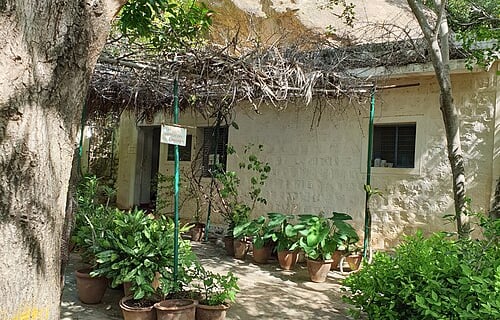

Ramana Maharishi's meditation cave
To access the Virupaksha Cave, also known as the Ramana Maharishi’s meditation cave, you can either hike from behind the Sri Ramanasramam for about 30 minutes or climb up Arunachala Hill from the Arunachaleswarar temple for 10 minutes. The cave is located on the hill and is a significant site for those interested in spirituality and following Ramana Maharishi’s teachings.
Down at the foothills, at the Sri Ramanasramam (Ramana Maharishi Ashram), visitors can explore several significant spaces that contribute to the ashram’s spiritual atmosphere. Notably, there is a small hall where devotees can meditate, reflect, and experience a peaceful environment. The hall often displays photographs and memorabilia of Ramana Maharshi, offering a glimpse into his life and teachings.
Additionally, the bookstore downstairs is a key feature, providing literature on Ramana Maharishi’s philosophy, including his teachings on self-inquiry and spiritual wisdom. Many visitors purchase books, audio recordings, and writings by and about the Maharshi, which offer deeper insights into his life and methods.
This is also home to the temple and meditation spaces, where one can participate in prayer and quiet contemplation. The atmosphere is serene and conducive to inner peace, reflecting the spiritual ambiance that has drawn seekers from around the world for decades.
The Skandashram
Skandashram is located near the Arunachaleswarar Temple and Virupaksha Cave, where Sri Ramana Maharshi spent a significant period of his life in Thiruvanamalai. Initially, he meditated in solitude at Virupaksha Cave for over 16 years. However, in 1916, he moved to Skandashram, partly due to the presence of his mother, Alagammal. From 1916 to 1922, Sage Ramana resided at Skandashram, where his mother cared for the meals of all, including his disciples. After her passing in 1922, Ramana Maharshi relocated to the present-day Ramana Ashram, situated near his mother’s shrine.
Having been the place where Sri Ramana Maharshi spent a significant portion of his life in deep meditation and spiritual practice, Skandashram holds a powerful, transformative energy. It is often described as a space where time slows down, and the mind can find stillness, facilitating a deeper connection with the inner self. The spiritual vibe of Skandashram is one of profound serenity, peace, and deep introspection.
The Seshadri ashram
Sri Seshadri Swamigal (swami means master – one who has control over one’s self & the “gal” is respectful, honorific suffix) was a revered saint and mystic who lived in Thiruvanamalai in the late 19th and early 20th centuries. Born as Sesha Iyer in 1867 in Villupuram, Tamil Nadu, he displayed spiritual inclinations from a young age. His life was marked by an intense connection to the divine, and he became known for his simple, unassuming nature, deep meditation, and remarkable spiritual powers. Upon reaching Thiruvanamalai, Seshadri Swamigal chose a life of austerity and solitude, meditating and living in the vicinity of the Arunachaleswarar Temple. He became well-known among the locals for his simplicity, profound wisdom, and compassion. Sri Seshadri Swamigal passed away in 1929, leaving behind a legacy of spiritual wisdom and compassion. His jeeva Samadhi (final resting place) is located in the Seshadri Ashram in Thiruvanamalai, which has since become an important pilgrimage site.
Sri Seshadri Swamigal was already well-established as a revered spiritual figure in Thiruvanamalai when Ramana Maharishi arrived in the town in 1896. At that time, Ramana Maharshi was just 16 years old, newly arrived in the town after his spiritual awakening at Virupaksha Cave on Arunachala Hill.
Seshadri Swamigal and Ramana Maharshi were both deeply devoted to Lord Shiva and followed paths of deep meditation and self-inquiry.
There are accounts that suggest Ramana Maharishi held great reverence for Seshadri Swamigal, seeing him as a spiritually advanced being. It's believed that Ramana Maharshi visited Seshadri Swamigal at his Ashram and may have received blessings and spiritual guidance from him, though their interactions were likely limited due to the Maharishi’s more solitary nature.
Seshadri Swamigal, for his part, was known to have recognized the profound spiritual presence of Ramana Maharshi even in his youth. In one instance, when Ramana Maharshi was still a young man, Seshadri Swamigal is said to have remarked that Ramana had attained a state of spiritual maturity and that he was a "great soul."
Girivalam – the circumambulation around the sacred mountain
Girivalam is term that is derived from two words – “Giri” meaning a mountain and “valam” meaning to come around. So, “Girivalam” means to come circumambulatory around the hill. The Arunachala Mountain itself is considered a manifestation of Shiva, revered and people come circumambulatory in propitiation.
The Girivalam path around Arunachala Hill is approximately 14 kilometres (8.7 miles) long. Pilgrims walk this distance as part of the sacred circumambulation, which is often done barefoot as an act of devotion and humility. The path takes them around the base of the hill, passing several temples, sacred sites, and natural landmarks. The journey is considered both physically and spiritually enriching, with devotees typically engaging in prayers and meditation along the way. It is a significant ritual, especially during full moon nights (Purnima) and festivals like Karthigai Deepam, when the hill is believed to radiate intense spiritual energy.
As you walk, you’ll be accompanied by other pilgrims, both local devotees and those from different parts of India or the world. Along the route, you may encounter small coconut vendors, Prasad (offering) stalls, and local shops selling religious items. You might be able to purchase offerings or take a brief rest before continuing your journey. The Girivalam path is well-marked, and signage in both Tamil and English is provided to guide pilgrims. This makes it easier for Western tourists to follow the route without getting lost.
Basic toilets are available at some key points along the Girivalam route, mainly near larger temples or at designated rest areas. However, they might not always be maintained to Western standards. It’s advisable to carry wet wipes or hand sanitizers for added convenience. Some cafes and guesthouses near the temples may also allow visitors to use their facilities.
AMENITIES & PUBLIC FACILITIES FOR VISITORS
Basic toilet facilities are available near the temple, typically managed by temple authorities or the local municipality. While these may not always be maintained to the highest standards, they are functional for visitors. Some guesthouses and cafes may also have restrooms available for their customers, providing more comfort.
SHOPPING & ESSENTIALS: WHAT TO BUY AND WHERE
You’ll find shops selling essential religious items and offerings. Items for the Puja (rituals) such as incense sticks, camphor, lamp oil, wicks, flowers, and holy ash (vibhuti). Coconuts and Fruits: Devotees often offer coconuts, bananas, and other fruits at the temple during their visit, and these can be bought from street vendors near the temple. Kumkum and Turmeric: Kumkum (red powder) and turmeric are used in Hindu rituals, and these can be found in many shops near the temple, often packaged for use as offerings. Sacred Rudraksha Beads: Rudraksha beads are used in Hinduism for prayer and meditation. These beads can be purchased in various forms, such as necklaces, bracelets, or individual beads, from the shops around the temple.
Small Statues and Idols: You’ll find miniature statues of Lord Shiva and other deities, which devotees often take as souvenirs or offerings. These are usually made of materials like brass, copper, or clay.
Traditional South Indian Handicrafts: Shops around the temple offer a range of traditional South Indian handicrafts, such as wooden carvings, stone sculptures, brass items, and pottery
Books and religious Literature: Shops around the temple do sell spiritual books, particularly those related to Ramana Maharshi, Shiva, and other Hindu deities. You can find works on meditation, self-realization, and other spiritual subjects.
WHY JUST READ IT WHEN YOU CAN LIVE IT? COME EXPLORE WITH ME!
With over two decades of experience in curating unforgettable journeys, we specialize in organizing tours across India, Southeast Asia, and select European destinations. Let us take you beyond the guidebooks and into the heart of each place we visit. Come travel with us—your adventure begins here.
